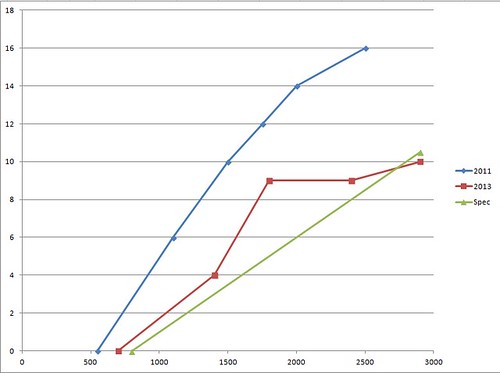
When I started blogging waaayyy back in April of ought-two, I had a number of reasons to record the highs and lows of the Corvair portion of my life. One of them was I knew I wouldn’t be able to trust my memory to dredge up every swap and adjustment I’d made over the years. “When, if ever, did I replace Heidi’s generator; or did I just rebuild the one that came with her?” “Is Ringo still running the same set of sparkplugs that went in when I rebuilt his engine, and when was that?” “Have I ever done anything with Glinda’s distributor?” The only way I would find the answers to questions like those – questions I really wanted answered – was to write (or in this case type) it all down as it happened.
This morning I was messing around with my all-inclusive Corvair spreadsheet and discovered I’d created another graph at some point showing Glinda’s advance versus rpm curve. That prompted me to search this blog using the keywords Glinda and distributor to see what I may have posted using the graph. Over a dozen posts popped up including the one dated February 3, 2011 where I discussed that old graph. At that time she was Victoria’s daily-driver and I was – surprise, surprise – trying to improve her gas mileage. I wrote that I’d gotten a list of things to check in reply to a CorvairCenter posting one of which was to verify that the proper distributor was being used since Chevy supplied different distributors with different advance curves depending on the engine/transmission combination. Not being able to find the number, I, instead, measured and plotted advance versus rpm. Take a look above where I've put up a new graph showing advance then and now compared to a revised spec curve. The interesting thing was the curve I plotted nearly two years ago does not match the curve I generated yesterday. Even more compelling is the old curve shows more advance than Chevy intended. With these anomalies, I went searching through the other posts to determine when, if ever, I’d replaced Glinda’s distributor.
Here’s a distributor time-line for Glinda. 12/9/2010: replaced original distributor with one from the shelf. 1/17/2011: rebuilt original distributor. 1/20/2011: finished rebuilding the original distributor. 1/25/2011: installed rebuilt original distributor. 2/8/2011: noticed dwell movement. 2/11/2011: made graph. 5/17/2012: rediscovered changing dwell. 6/21/2012: replaced points plate. 11/6/2012: noticed fuel improvement, attributed to "rebuilt distributor".
So where do I go from here? Well, first I’ll open up the distributor, remove the points plate, and thoroughly clean and lubricate the weights and springs with the hope that more advance will kick in. More is better unless it results in pinging. Second, I still believe the carbs are running rich, so I’ll try to get TwoTone’s rebuilt carbs corrected and swap them on to Glinda to test my theory. Finally, as a buddy of mine at work is urging me to do, I’ll “just get the 140/4-speed project done and installed.”
Feel free to bypass this paragraph regarding the ongoing truck saga if you are only here to catch up on Corvair activities. As I reported yesterday, the seal I’d gotten hadn’t fit correctly. I decided to bite the bullet, pay the big bucks, and go to the Chevrolet dealership to get the “right” parts. After calling the parts department and giving them the truck’s VIN, the parts counter-person looked up the yoke kit (which includes a seal) and lo-and-behold they came up with a part number different than the one I’d bought online. They had the kit in stock, so my VISA card took a $160 dollar hit, but I was still happy to walk out of there with “right” parts. I got home and immediately walked to the truck to compare the “right” parts with those I’d pulled off the truck. To my IMMENSE disappointment, the “right” parts I’d bought were not right. The yoke was much significantly larger and there was no way it would work. A phone call this morning to the dealership, with a different counter-person on the line, and I now have a different part number for the “right” kit. Of course, he had no idea why my VIN spat out the wrong part number yesterday. Today I was smart enough to bring the old parts in with me so when I went there at lunch, I was able to set new and old side-by-side and it appears they are the same this time. The part’s guy did a little research and discovered the VIN he’d heard me tell him over the phone yesterday had an E, rather than the Z it should have – he misheard me. To add insult to injury, the right yoke is smaller than the wrong yoke, yet it cost me an additional $19.

No comments:
Post a Comment